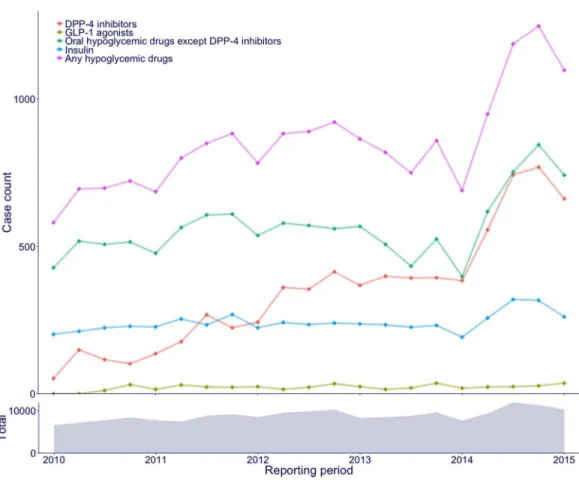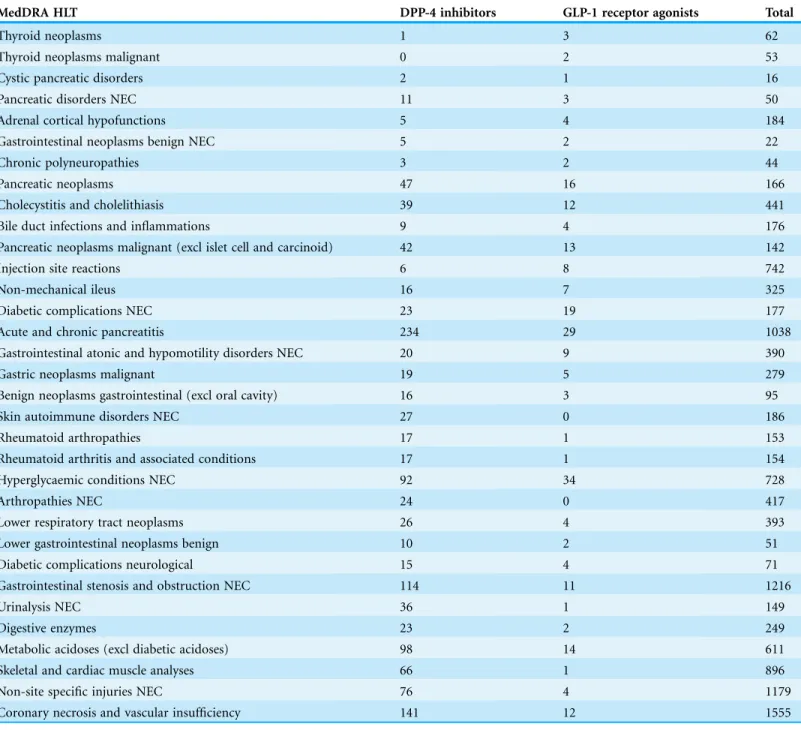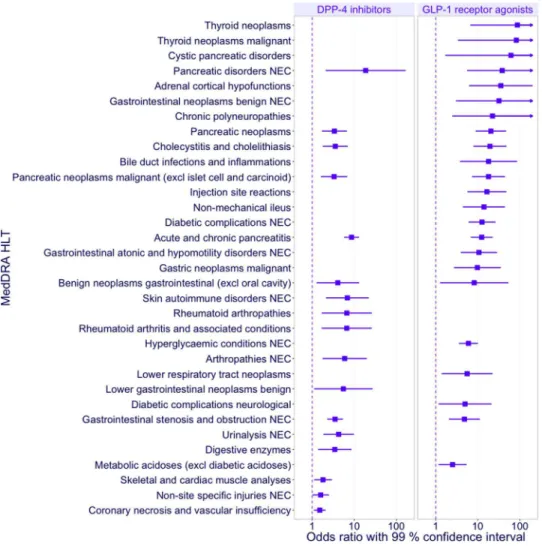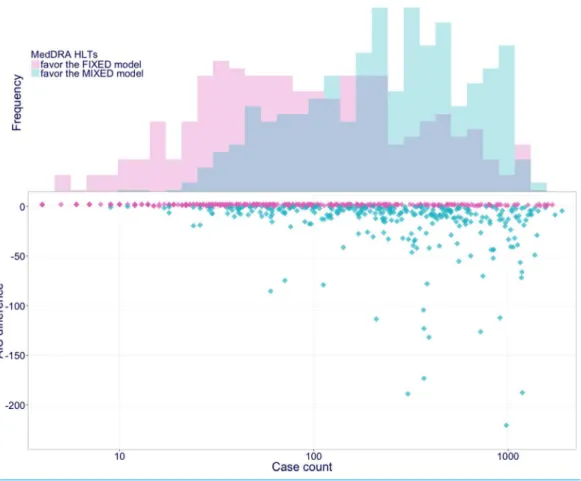Adverse events associated with
incretin-based drugs in Japanese
spontaneous reports: a mixed effects
logistic regression model
Daichi Narushima1, Yohei Kawasaki1, Shoji Takamatsu2and Hiroshi Yamada1
1Drug Evaluation & Informatics, University of Shizuoka, Shizuoka, Shizuoka, Japan 2Office of Safety II, Pharmaceuticals and Medical Devices Agency, Tokyo, Japan
ABSTRACT
Background: Spontaneous Reporting Systems (SRSs) are passive systems
composed of reports of suspected Adverse Drug Events (ADEs), and are used for Pharmacovigilance (PhV), namely, drug safety surveillance. Exploration of analytical methodologies to enhance SRS-based discovery will contribute to more effective PhV. In this study, we proposed a statistical modeling approach for SRS data to address heterogeneity by a reporting time point. Furthermore, we applied this approach to analyze ADEs of incretin-based drugs such as DPP-4 inhibitors and GLP-1 receptor agonists, which are widely used to treat type 2 diabetes.Methods: SRS data were obtained from the Japanese Adverse Drug Event Report (JADER) database. Reported adverse events were classified according to the MedDRA High Level Terms (HLTs). A mixed effects logistic regression model was used to analyze the occurrence of each HLT. The model treated DPP-4 inhibitors, GLP-1 receptor agonists, hypoglycemic drugs, concomitant suspected drugs, age, and sex as fixed effects, while the quarterly period of reporting was treated as a random effect. Before application of the model, Fisher’s exact tests were performed for all drug-HLT combinations. Mixed effects logistic regressions were performed for the HLTs that were found to be associated with incretin-based drugs. Statistical significance was determined by a two-sided p-value <0.01 or a 99% two-sided confidence interval. Finally, the models with and without the random effect were compared based on Akaike’s Information Criteria (AIC), in which a model with a smaller AIC was considered satisfactory.
Results: The analysis included 187,181 cases reported from January 2010 to March 2015. It showed that 33 HLTs, including pancreatic, gastrointestinal, and
cholecystic events, were significantly associated with DPP-4 inhibitors or GLP-1 receptor agonists. In the AIC comparison, half of the HLTs reported with
incretin-based drugs favored the random effect, whereas HLTs reported frequently tended to favor the mixed model. Conclusion: The model with the random effect was appropriate for analyzing frequently reported ADEs; however, further exploration is required to improve the model. The core concept of the model is to introduce a random effect of time. Modeling the random effect of time is widely applicable to various SRS data and will improve future SRS data analyses.
Submitted10 December 2015 Accepted12 February 2016 Published8 March 2016 Corresponding author
Hiroshi Yamada,
hyamada@u-shizuoka-ken.ac.jp
Academic editor
Massimiliano Zanin
Additional Information and Declarations can be found on page 10
DOI10.7717/peerj.1753
Copyright
2016 Narushima et al.
Distributed under
Subjects Drugs and Devices, Epidemiology, Pharmacology, Statistics
Keywords Adverse drug events, Spontaneous reporting systems, Logistic regression, Incretin-based drugs
INTRODUCTION
The incretins are a group of intestinal hormones that stimulate insulin secretion. During the last decade, several hypoglycemic drugs based on incretin have gained widespread use as treatments for patients with type 2 diabetes. Incretin-based drugs are classified as inhibitors of incretin-degrading protease Dipeptidyl Peptidase 4 (DPP-4) or as incretin hormone Glucagon-Like Peptide 1 (GLP-1) receptor agonists. DPP-4 inhibitors and GLP-1 receptor agonists lower fasting and postprandial glucose, but do not produce hypoglycemia and are not associated with body weight gain or reduced in blood pressure (Nauck, 2013).
DPP-4 inhibitors and GLP-1 receptor agonists have been associated with adverse outcomes, including pancreatic disorders, although some of these findings are
controversial (Butler et al., 2013;Devaraj & Maitra, 2014;Nauck, 2013). An analysis of the US Food and Drug Administration (FDA) Adverse Event Reporting System (FAERS) revealed that use of DPP-4 inhibitor sitagliptin or GLP-1 receptor agonist exenatide increased the Odds Ratio (OR) for pancreatitis more than 6-fold, while increasing the OR for pancreatic cancer more than 2-fold, in comparison with other medications (Elashoff et al., 2011); however, most other clinical studies have demonstrated no evidence suggesting such risks (Li et al., 2014;Nauck, 2013). The FDA and European Medicines Agency (EMA) explored multiple streams of data and agreed that assertions concerning a causal association between incretin-based drugs and pancreatitis or pancreatic cancer were inconsistent with the current data (Egan et al., 2014).
Spontaneous Reporting Systems (SRSs) such as the FAERS are passive systems composed of reports of suspected Adverse Drug Events (ADEs) collected from
healthcare professionals, consumers, and pharmaceutical companies (Harpaz et al., 2012). SRSs play an essential role in Pharmacovigilance (PhV), which is also referred to as drug safety surveillance. Although SRSs cover large populations, their data have some biases in reporting. In the case of incretin-based drugs in the FAERS, reporting of pancreatitis was largely influenced by the relevant FDA alerts in an example of notoriety bias, which could cause overestimation of risk (Raschi et al., 2013). Spontaneous reporting patterns change over time, which is one of the limitations of SRSs (Bate & Evans, 2009). SRSs have numerous limitations; nevertheless, PhV has relied
predominantly on SRSs (Gibbons et al., 2010;Harpaz et al., 2012). Therefore, exploration of novel analytical methodologies to enhance SRS-based discovery will highlight the value of SRSs and contribute to more effective PhV.
The most conventional analytical approach for SRS data is Disproportionality Analyses (DPA). DPA methodologies use frequency analysis of 22 contingency tables to quantify the degree to which a drug-event combination co-occurs
however, these do not adjust for confounding factors. The alternatives to DPA are multivariate modeling techniques such as logistic regression. Multivariate modeling techniques can adjust for potential confounding and masking factors during the analysis of drug-event relationships (Harpaz et al., 2013). In a performance evaluation using the FAERS, approaches based on logistic regression outperformed DPA approaches (Harpaz et al., 2013).
The objectives of the present study are to propose a novel multivariate modeling approach for SRS data and to apply this approach to analyze ADEs associated
with incretin-based drugs from an SRS. We designed a mixed effects logistic regression model and performed comprehensive analyses using this model. The analyzed data were obtained from the Japanese Adverse Drug Event Report (JADER) database
maintained by the Pharmaceuticals and Medical Devices Agency (PMDA) (PMDA, 2015). Most case reports in the FAERS are from consumers or lawyers, whereas those in the JADER are medically confirmed (Nomura et al., 2015). The analyses were based mainly on mixed effects logistic regression, in which DPA were used adjunctively. Mixed effects logistic regression models contain variables for random effects in addition to those for fixed effects similar to conventional logistic regression models. The random variable in a logistic regression model describes the ramifications of different sources of heterogeneity and associations between outcomes (Larsen et al., 2000). Mixed effects logistic
regression model is a type of Generalized Linear Mixed Models (GLMMs). The use of GLMMs in medical literature has recently increased to take into account data
correlations when modeling binary or count data (Casals, Girabent-Farres & Carrasco, 2014); however, applications of GLMMs to SRS data have been reported rarely. As a rare application of GLMMs to SRS data, an approach based on a mixed effects Poisson regression model was proposed (Gibbons et al., 2008). This approach yields rate
multipliers for each drug in a class of drugs, which describe the deviation of the rate for a specific adverse event from that for the drug class as a whole. In contrast, the present approach is based on a logistic regression model with a random effect of time and addresses heterogeneity between time points. Since reporting-time-point is an attribute common to SRSs, modeling the random effect of time is widely applicable to any ADE in any SRS. Nevertheless, to the best of our knowledge, modeling approaches such as this have not been reported. This is the first application of a logistic regression model with a random effect of time to SRS data.
MATERIAL AND METHODS
Data source
The JADER dataset, which was published in July 2015 and contained 353,988 unique cases, was obtained from the website of the PMDA. The analyzed cases were reported from January 2010 to March 2015 and had available records regarding age and sex.
and HLGTs are grouped into “System Organ Classes” (SOCs). Before data analyses, a relational database was constructed from the JADER dataset and MedDRA/J version 18.0. SQLite version 3.8.5 was used as the database management system (SQLite Development Team, 2015).
As incretin-based drugs, all DPP-4 inhibitors and GLP-1 receptor agonists approved in Japan were assessed. The DPP-4 inhibitors were sitagliptin phosphate hydrate, vildagliptin, alogliptin benzoate, alogliptin benzoate/pioglitazone hydrochloride (combination drug), linagliptin, teneligliptin hydrobromide hydrate, anagliptin, and saxagliptin hydrate. The GLP-1 receptor agonists were exenatide, liraglutide, and lixisenatide.
Data analysis
The analysis of ADEs associated with incretin-based drugs was composed of two phases. The first phase was a DPA based on Fisher’s exact test. The second phase was a
multivariate analysis using a mixed effects logistic regression model.
The PTs of ADEs were classified according to the MedDRA HLTs. All combinations of generic drug names and HLTs were extracted. Fisher’s exact tests were performed for all combinations of incretin-based drugs and reported HLTs. Associations that yielded a two-sided p-value <0.01 and an OR >1 were considered significant.
Mixed effects logistic regressions were performed for each HLT significantly associated with incretin-based drugs. The mixed effects logistic regression model was as follows:
P Yð i ¼1jxi;ziÞ
P Yð i ¼0jxi;ziÞ
¼exp xiTþziTu
WhereYiis a binary variable describing the outcome of casei(0 or 1), bis a fixed parameter vector, xiis a covariate vector for fixed effects, uis a vector of random variables from probability distributions, andziis a covariate vector for random effects.
urepresents unmeasured covariates as a way of modeling heterogeneity and correlated data (Larsen et al., 2000).
In the newly developed model, the binary outcome was whether or not each HLT was reported. For fixed effects, the covariates were use of DPP-4 inhibitors, use of GLP-1 receptor agonists, use of any hypoglycemic drugs (an alternative indicator for
hyperglycemia), sum of concomitant suspected drugs (determined by reference to the Fisher’s exact tests), age (in 10-year intervals), and sex. The random effect was the quarterly period of reporting. The variables for the random effect were random intercepts normally distributed with mean 0 and one common variance. The associations
between incretin-based drugs and HLTs were assessed by ORs with 99% two-sided Wald-type Confidence Intervals (CIs). Because the present analysis was an exploratory screening, the problem of multiple comparison was not addressed. Instead of correcting that, stringent levels of statistical significance were set (p-value <0.01 and 99% CI).
performed for all reported HLTs associated with incretin-based drugs. Subsequently, the adequacy of the model was assessed by Akaike’s Information Criteria (AIC) (Burnham & Anderson, 2002). A model with a smaller AIC was favored.
All analyses were performed using the R version 3.2.1 (R Development Core Team, 2010). The glmmML package version 1.0 was used with the “ghq” (Gauss-Hermite quadrature) method for the mixed effects logistic regressions (Brostro¨m, 2013).
RESULTS
Description of the analyzed case reports
The JADER included 204,472 unique cases that were reported from January 2010 to March 2015, of which 187,181 had available records for age and sex and were analyzed. The records included 4,952 generic drug names and 6,151 PTs under 1,377 HLTs. DPP-4 inhibitors were mentioned in 7,265 cases, whereas GLP-1 receptor agonists were mentioned in 451 cases.Figure 1shows the number of cases mentioning hypoglycemic drugs that were reported during each quarterly period. Although the number of cases for other hypoglycemic drugs increased gradually over time, the number of cases for DPP-4 inhibitors increased markedly.
Mixed effects logistic regressions
The cases associated with incretin-based drugs included 1,430 PTs under 735 HLTs. The Fisher’s exact tests showed that 106 of the 735 HLTs were significantly associated with any incretin-based drug (two-sided p-value <0.01 and OR >1). In the
mixed effects logistic regressions, 33 of the 106 HLTs identified by the Fisher’s exact tests were significantly associated with DPP-4 inhibitors or GLP-1 receptor agonists
(99% two-sided CI).Table 1shows the number of cases reported for each HLT. Table 1 Case counts of adverse events associated with DPP-4 inhibitors or GLP-1 receptor agonists.
MedDRA HLT DPP-4 inhibitors GLP-1 receptor agonists Total
Thyroid neoplasms 1 3 62
Thyroid neoplasms malignant 0 2 53
Cystic pancreatic disorders 2 1 16
Pancreatic disorders NEC 11 3 50
Adrenal cortical hypofunctions 5 4 184
Gastrointestinal neoplasms benign NEC 5 2 22
Chronic polyneuropathies 3 2 44
Pancreatic neoplasms 47 16 166
Cholecystitis and cholelithiasis 39 12 441
Bile duct infections and inflammations 9 4 176
Pancreatic neoplasms malignant (excl islet cell and carcinoid) 42 13 142
Injection site reactions 6 8 742
Non-mechanical ileus 16 7 325
Diabetic complications NEC 23 19 177
Acute and chronic pancreatitis 234 29 1038
Gastrointestinal atonic and hypomotility disorders NEC 20 9 390
Gastric neoplasms malignant 19 5 279
Benign neoplasms gastrointestinal (excl oral cavity) 16 3 95
Skin autoimmune disorders NEC 27 0 186
Rheumatoid arthropathies 17 1 153
Rheumatoid arthritis and associated conditions 17 1 154
Hyperglycaemic conditions NEC 92 34 728
Arthropathies NEC 24 0 417
Lower respiratory tract neoplasms 26 4 393
Lower gastrointestinal neoplasms benign 10 2 51
Diabetic complications neurological 15 4 71
Gastrointestinal stenosis and obstruction NEC 114 11 1216
Urinalysis NEC 36 1 149
Digestive enzymes 23 2 249
Metabolic acidoses (excl diabetic acidoses) 98 14 611
Skeletal and cardiac muscle analyses 66 1 896
Non-site specific injuries NEC 76 4 1179
Figure 2 shows ORs with 99% CIs for the significant associations between HLTs and DPP-4 inhibitors or GLP-1 receptor agonists. “NEC” in the MedDRA terms is an acronym for “Not Elsewhere Classified,” which denotes groupings of miscellaneous terms, whereas “excl” is an abbreviation of “excluding.” The HLTs associated with DPP-4 inhibitors included “Pancreatic disorders NEC” (OR 18.66; 99% CI 2.09–166.25) and “Acute and chronic pancreatitis” (8.65; 5.76–12.98). The HLTs associated with GLP-1 receptor agonists included “Thyroid neoplasms” (87.25; 6.64–1146.27) and “Cystic pancreatic disorders” (61.32; 1.69–2224.49). The HLTs associated with
DPP-4 inhibitors and GLP-1 receptor agonists indicated pancreatic events (“Acute and chronic pancreatitis,” “Pancreatic neoplasms,” “Pancreatic neoplasms malignant
(excl islet cell and carcinoid),” and “Pancreatic disorders NEC”), gastrointestinal events (“Benign neoplasms gastrointestinal (excl oral cavity)” and “Gastrointestinal stenosis and obstruction NEC”), and cholecystic events (“Cholecystitis and cholelithiasis”). Although DPP-4 inhibitors and GLP-1 receptor agonists were not associated with
Figure 2 Odds ratios of the adverse events associated with DPP-4 inhibitors or GLP-1 receptor
hypoglycemic events, GLP-1 receptor agonists were associated with several
HLTs related to diabetes, including “Hyperglycaemic conditions NEC” and “Diabetic complications NEC.”
Comparison between the models with and without the random effect Figure 3shows the comparison between the models with (mixed model) and without (fixed model) the random effect. In 604 of the 735 HLTs reported with incretin-based drugs, the AIC of the models were calculated normally. Of the 604 HLTs,
302 favored the mixed model, whereas the others favored the fixed model. The median number of reported cases for the group of HLTs favoring the mixed model was 264, whereas the median number of reported cases for the group of HLTs favoring the fixed model was 83; thus, HLTs reported frequently tended to favor the mixed model.
DISCUSSION
Time-series variation of spontaneous reports
SRSs accumulate a large amount of data regarding ADEs every year; thus, the contents of SRSs are not constant. In the present study, the report composition of
hypoglycemic drug groups varied during the study period. Reports associated with DPP-4 inhibitors showed a marked increase in comparison with that of reports associated with other hypoglycemic drugs, perhaps because of an increasing number of approved products and an associated increase in drug use. The number of reports during a particular period is affected by numerous factors. This variation in reporting results in temporal heterogeneity, supporting the appropriateness of the mixed model.
Adverse events associated with incretin-based drugs
Some HLTs associated with incretin-based drugs in the present study have been reported as issues of concern in previous studies. Some groups of similar HLTs, e.g., “Thyroid neoplasms” and “Thyroid neoplasms malignant” were identified because some PTs are linked to multiple HLTs in the MedDRA. In comparison with DPP-4 inhibitors,
GLP-1 receptor agonists showed relatively wide CIs for some of the HLTs because fewer cases were reported, leading to unreliable results.
In the present study, pancreatic disorders, including pancreatitis and pancreatic cancer, were associated with DPP-4 inhibitors and GLP-1 receptor agonists, which were
consistent with results obtained via analysis of the FAERS (Butler et al., 2013;Elashoff et al., 2011). In addition, thyroid cancer was associated with GLP-1 receptor agonists; however, because of the small number of cases, this finding is unreliable. Analyses of the FAERS also indicated that GLP-1 receptor agonists increased ORs for thyroid cancer (Butler et al., 2013;Elashoff et al., 2011). Thyroid cancer and pancreatic disorders are among the most controversial safety concerns regarding incretin-based drugs; however, no evidence has been found for such risks in human clinical studies (Butler et al., 2013;Nauck, 2013). The other HLTs associated with DPP-4 inhibitors and GLP-1 receptor agonists were “Benign neoplasms gastrointestinal (excl oral cavity),” “Gastrointestinal stenosis and obstruction NEC,” and “Cholecystitis and cholelithiasis.” Gastrointestinal events such as nausea, vomiting, and diarrhea are common ADEs of incretin-based drugs (Nauck, 2011); however, benign gastrointestinal neoplasms, stenosis, and obstruction have not been referred to in past studies. Cholecystic events have not in the same way.
Hypoglycemia, an adverse event associated with some hypoglycemic drugs, was not associated with incretin-based drugs. In contrast, hyperglycemia and several other diabetic complications were associated with GLP-1 receptor agonists, perhaps because of cases of ineffective drug treatment.
Limitations
The limitations of SRS data mining include confounding by indication (i.e., patients taking a particular drug may have a disease that is itself associated with a higher incidence of the adverse event), systematic under-reporting, questionable
The newly developed model reported here addresses the confounding influences of temporal heterogeneity and concomitant drug use. Nevertheless, risks identified via analysis of SRS data should be considered as safety signals, rather than definitive statements of cause and effect. For further interpretation of each ADE, additional reviews of other data sources are recommended.
Mixed effects logistic regression model
In the AIC comparison between the mixed model and the fixed model, half of the HLTs reported with incretin-based drugs favored each model. The HLTs that favored the mixed model were reported more frequently than those that favored the fixed model, indicating that the mixed model may be more appropriate for frequently reported ADEs. The AIC formula has a bias-correction term for the number of estimable parameters (Burnham & Anderson, 2002). In the above comparison, the mixed model has only one more parameter than does the fixed model; hence, the
difference between the penalties for the correction is small.
The adequacy of the random effect was demonstrated; however, the model can be improved. Although we assumed a normal distribution for the random effect, the appropriateness of this assumption is unclear. Moreover, it is unclear whether a single probability distribution is sufficient to assess the random effect on the widely spread time-scale of spontaneous reports. Sampling of parameter distributions by Bayesian hierarchical modeling is a potential solution to these problems. Currently, diverse implementations of Bayesian methods, which support practice of such modeling, are accessible (Li et al., 2011;MacLehose & Hamra, 2014).
CONCLUSION
We proposed a logistic regression model for SRS data taking into account the random effect of time and applied this model to analyze ADEs reported with incretin-based drugs in the JADER. The newly developed model was appropriate for ADEs
reported frequently; however, further exploration is required to improve the model. The core concept of the newly developed model is to introduce a random effect of time. The random effect introduced into a univariate or multivariate model addresses heterogeneity by time unit. Reporting-time-point is an attribute common to all spontaneous reports. Hence, modeling the random effect of time is widely applicable to various SRS data and will improve future statistical analyses of SRS data.
ADDITIONAL INFORMATION AND DECLARATIONS
Funding
This work was supported by a grant from the Japanese Ministry of Health, Labour and Welfare. The funders had no role in study design, data collection and analysis,
decision to publish, or preparation of the manuscript.
Competing Interests
Author Contributions
Daichi Narushima conceived and designed the experiments, performed the
experiments, analyzed the data, contributed reagents/materials/analysis tools, wrote the paper, prepared figures and/or tables, reviewed drafts of the paper.
Yohei Kawasaki analyzed the data, wrote the paper, prepared figures and/or tables, reviewed drafts of the paper.
Shoji Takamatsu conceived and designed the experiments, contributed reagents/ materials/analysis tools, reviewed drafts of the paper.
Hiroshi Yamada conceived and designed the experiments, reviewed drafts of the paper.
Data Deposition
The following information was supplied regarding data availability:
The Japanese authority, PMDA, which owns this date, does not permit sharing of the data directly. It can be accessed here:https://www.pmda.go.jp/safety/info-services/drugs/ adr-info/suspected-adr/0005.html(in Japanese).
REFERENCES
Bate A, Evans SJ. 2009.Quantitative signal detection using spontaneous ADR reporting.
Pharmacoepidemiology and Drug Safety18(6):427–436DOI 10.1002/pds.1742.
Brewer T, Colditz GA. 1999.Postmarketing surveillance and adverse drug reactions: current
perspectives and future needs.JAMA281(9):824–829DOI 10.1001/jama.281.9.824.
Brostro¨m G. 2013.glmmML: generalized linear models with clustering.Available at
http://CRAN.R-project.org/package=glmmML.
Burnham KP, Anderson DR. 2002.Model Selection and Multimodel Inference: A Practical
Information-Theoretic Approach. New York: Springer Science & Business Media DOI 10.1007/b97636.
Butler PC, Elashoff M, Elashoff R, Gale EA. 2013.A critical analysis of the clinical use of
incretin-based therapies: are the GLP-1 therapies safe?Diabetes Care36(7):2118–2125 DOI 10.2337/dc12-2713.
Casals M, Girabent-Farres M, Carrasco JL. 2014.Methodological quality and reporting of
generalized linear mixed models in clinical medicine 2000–2012: a systematic review. PLoS ONE9(11):e112653DOI 10.1371/journal.pone.0112653.
Devaraj S, Maitra A. 2014.Pancreatic safety of newer incretin-based therapies: are the “-tides”
finally turning?Diabetes63(7):2219–2221DOI 10.2337/db14-0545.
Egan AG, Blind E, Dunder K, de Graeff PA, Hummer BT, Bourcier T, Rosebraugh C. 2014.
Pancreatic safety of incretin-based drugs–FDA and EMA assessment.New England Journal of Medicine370:794–797DOI 10.1056/NEJMp1314078.
Elashoff M, Matveyenko AV, Gier B, Elashoff R, Butler PC. 2011.Pancreatitis, pancreatic,
and thyroid cancer with glucagon-like peptide-1-based therapies.Gastroenterology
141(1):150–156DOI 10.1053/j.gastro.2011.02.018.
Gibbons RD, Amatya AK, Brown CH, Hur K, Marcus SM, Bhaumik DK, Mann JJ. 2010.
Post-approval drug safety surveillance.Annual Review of Public Health31:419–437 DOI 10.1146/annurev.publhealth.012809.103649.
Gibbons RD, Segawa E, Karabatsos G, Amatya AK, Bhaumik DK, Brown CH, Kapur K,
reports: the relationship between antidepressants and suicide.Statistics in Medicine
27(11):1814–1833DOI 10.1002/sim.3241.
Harpaz R, DuMouchel W, LePendu P, Bauer-Mehren A, Ryan P, Shah NH. 2013.Performance of
pharmacovigilance signal-detection algorithms for the FDA adverse event reporting system. Clinical Pharmacology & Therapeutics93(6):539–546DOI 10.1038/clpt.2013.24.
Harpaz R, DuMouchel W, Shah NH, Madigan D, Ryan P, Friedman C. 2012.Novel data-mining
methodologies for adverse drug event discovery and analysis.Clinical Pharmacology & Therapeutics91(6):1010–1021DOI 10.1038/clpt.2012.50.
Larsen K, Petersen JH, Budtz-Jorgensen E, Endahl L. 2000.Interpreting parameters in the
logistic regression model with random effects.Biometrics56(3):909–914 DOI 10.1111/j.0006-341X.2000.00909.x.
Li B, Lingsma HF, Steyerberg EW, Lesaffre E. 2011.Logistic random effects regression models:
a comparison of statistical packages for binary and ordinal outcomes. BMC Medical Research Methodology 11:77DOI 10.1186/1471-2288-11-77.
Li L, Shen J, Bala MM, Busse JW, Ebrahim S, Vandvik PO, Rios LP, Malaga G, Wong E, Sohani Z,
Guyatt GH, Sun X. 2014.Incretin treatment and risk of pancreatitis in patients with
type 2 diabetes mellitus: systematic review and meta-analysis of randomised and non-randomised studies.BMJ348:g2366DOI 10.1136/bmj.g2366.
MacLehose RF, Hamra GB. 2014.Applications of Bayesian methods to epidemiologic research.
Current Epidemiology Reports1(3):103–109DOI 10.1007/s40471-014-0019-z.
MedDRA. 2015.MedDRA: Medical Dictionary for Regulatory Activities.Available at
http://www.meddra.org/.
Nauck MA. 2011.Incretin-based therapies for type 2 diabetes mellitus: properties, functions,
and clinical implications.American Journal of Medicine124(1):S3–S18 DOI 10.1016/j.amjmed.2010.11.002.
Nauck MA. 2013.A critical analysis of the clinical use of incretin-based therapies: the benefits by
far outweigh the potential risks.Diabetes Care36(7):2126–2132DOI 10.2337/dc12-2504.
Nomura K, Takahashi K, Hinomura Y, Kawaguchi G, Matsushita Y, Marui H, Anzai T,
Hashiguchi M, Mochizuki M. 2015.Effect of database profile variation on drug safety
assessment: an analysis of spontaneous adverse event reports of Japanese cases.Journal of Drug Design, Development and Therapy9:3031–3041DOI 10.2147/DDDT.S81998.
PMDA. 2015.Pharmaceuticals and Medical Devices Agency.Available athttps://www.pmda.go.jp/
english/index.html.
R Development Core Team. 2010.R: A Language and Environment for Statistical Computing.
Vienna: the R Foundation for Statistical Computing.Available athttp://www.R-project.org/.
Raschi E, Piccinni C, Poluzzi E, Marchesini G, De Ponti F. 2013.The association of
pancreatitis with antidiabetic drug use: gaining insight through the FDA pharmacovigilance database.Acta Diabetologica50(4):569–577DOI 10.1007/s00592-011-0340-7.



